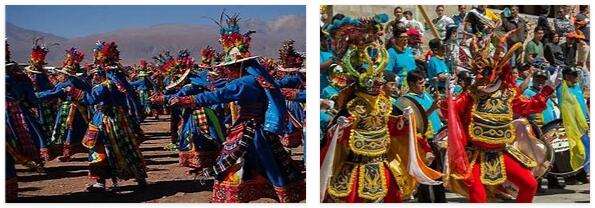What is typical for Chile?
Cueca
Music and dance are very important to the people in Chile as in all of Latin America. A dance called Cueca has been made a national dance. The man and woman dance with a white handkerchief in their right hand. During the period of the military dictatorship (1973-1990), the Cueca was also an expression of protest: women looking for relatives danced the Cueca alone and in silence and had photos of the missing people pinned to their chests. By the way, all children learn Cueca at school!
Huaso
The Huaso (pronounced: U-asso) is the Chilean cowboy. The Huaso wears special equestrian clothing. This includes the chupalla straw hat and a poncho. Huasos often appear at parades and festivals. At the rodeo, two huasos have to catch several cattle with their horses.
Rayuela
Popular sports among spectators are football and tennis. Chileans even get work-free at important football matches. Rayuela, however, is considered a national sport. This is a game of throwing in which you have to hit a white ribbon that is placed over half of a slightly inclined playing field. A special throwing device called the Tejo is thrown. Usually two teams compete against each other.
To celebrate
Carnival is particularly lavishly celebrated. This is typical for all of Latin America. In the city of Arica in the very north of Chile, the Andean Carnival is celebrated for three days with music, parades and dancing.
The streets and houses are decorated in Chile at Christmas, but Christmas Eve is a day like any other, except that you eat together in the evening. Then there is only one public holiday, December 25th. New Year’s Eve is celebrated bigger, but especially the national holidays. These are the Fiestas Patrias.
Fiestas Patrias
On September 18th and 19th, Chile celebrates the Fiestas Patrias. These are the day of the government junta of 1810 (with which the Chilean struggle for independence began) and the day of the Army. A large military parade is held on the latter every year. In addition, people celebrate lively, eat national specialties and celebrate old traditions such as the Cueca dance, rodeo or Rayuela. In the streets, people meet in so-called fondas, where people dance, grill, eat and play.
What would you be called in Chile?
If you were born in Chile what would you be called? Chances are, your last name would be González, Muñoz, Rojas, Díaz, or Pérez. These are the five most common surnames in Chile. They are all of Spanish origin. Sometimes that can be narrowed down, so the names Riquelme or Salazar are typical of the origins in the Basque Country. To get more information on Chile and America, check aparentingblog.
German or English surnames, for example, are less common, but they also exist because many nations emigrated to Chile in the 19th and 20th centuries. The artist Guillermo Deisler and the director Orlando Lübbert are examples of Chileans with German roots. The ancestors of the President of Chile, Michelle Bachelet, came from France, which is also evident in her name. The Chilean presenter Cecilia Bolocco has Italian ancestors.
Two surnames
Each child receives two surnames: one from the father and one from the mother. For example, if Juan Pérez González and Sofía Duarte López’s child were to be called Francisca, the full name would be: Francisca Pérez Duarte. Everyone keeps their name when they get married. So there is no common family name. It is common, however, to show that a woman is married to add a “de” and the man’s name. Sofía Duarte López would then call herself Sofía Duarte de Pérez. But that would not be their official name. What would your parents be called under this system and what would you be?
And which first names are popular in Chile? Girls are often called Sofía, Emilia, Martina, Florencia or Carolina. Ana María, Antonella and Catalina are also popular. Boys are often called Agustín, Luis Alberto, Vicente, Matías, Martin, Alonso, Juan Carlos or Cristian Andrés.
